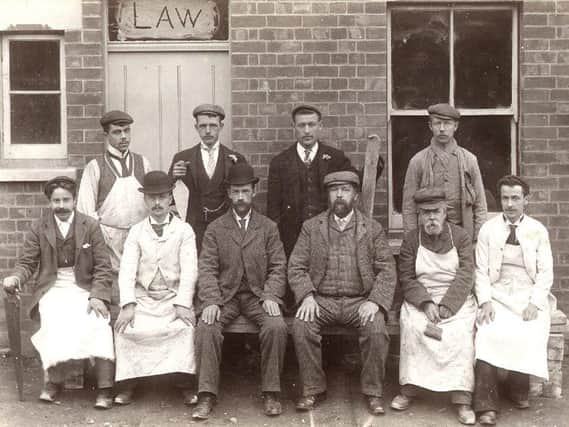The Monks Kirby woman with 42 kids and the man who fled Charles II - former Advertiser reporter shares weird and wonderful tales


When I was a reporter on the Rugby Advertiser back in the 1960s, there was no such thing as downtime.
If there was a scarcity of events in the office diary marked down to cover, and chief reporter Len Archer caught you daydreaming, or perhaps lingering too long in conversation, he would fix you with his beady blue eyes and say: “Boy. What are you doing? Ah yes, nothing. So get on your noddy bike and find some stories.”
Advertisement
Hide AdAdvertisement
Hide AdWell, Len probably didn’t know it, but this for me was a blessing in disguise, because it meant that for the next few hours I would be free from writing up village reports and making tea for the other reporters.
Oh yes. And if it was fine weather, then all the better for travelling on two wheels around the Rugby area in my relentless quest to root out that elusive scoop.
My usual ports of call would be post offices, rectories and village shops, the inhabitants of which were always good for local gossip.
Failing that, there were always notice boards to scrutinise.
Advertisement
Hide AdAdvertisement
Hide AdYou’d be amazed to learn how many stories can be found hidden away in those biro scribbled notes fixed on felt with a drawing pin on a board attached to a village hall.
Quite often, however, it was possible to learn about some story of the past, usually by talking to an old villager as he supped his pint of ale on a bench outside his local.
Take this one for instance. I vividly recall chatting to an old timer outside the Denbigh Arms in Monks Kirby. He seemed as old as Methuselah, what with his rather scarce dental attributes, and a face that had see many a hay meadow summer.
“So lad,” he said to me. “Did you know that a woman from Monks Kirby had the largest number of children ever recorded in England?” Needless to say, I certainly hadn’t, which was his cue to tell me all about her.
Advertisement
Hide AdAdvertisement
Hide AdApparently, Elizabeth Mott had been born in Monks Kirby around 1720. She married in her teens and, over a 44-year marriage, gave birth to no less than 42 children.
Now, it’s going back a bit now, and I haven’t been to the church for years, but I’m told there is an inscription on her grave which reads: A loving wife, a tender mother, scarce left behind her such another.
During the 16th century, Monks Kirby was also the home of minor poet Sir Henry Goodyer, who, along with William Shakespeare, was a good friend of the Warwickshire playwright Michael Drayton.
Talking of gravestones, there used to be an interesting one in Brinklow churchyard that marked the last resting place of Thomas Bolton, a deaf and dumb woodcutter.
Advertisement
Hide AdAdvertisement
Hide AdEngraved on the stone that marks his last resting place is an axe, a tree trunk and glove. No doubt he felled many an elm tree, now tragically absent from my beloved home county of Warwickshire, thanks to the ravages of Dutch Elm disease.
Just over the fields from Brinklow is my home village of Churchover.
When the Old Rectory grounds were being developed in the late 1960s, my late father was on the parish council.
He made several calls for the new development to be named after John Dixwell, one of the signatories to the death warrant of Charles I, but to no avail as the developers turned him down.
Advertisement
Hide AdAdvertisement
Hide AdJohn Dixwell was related to the family of that name who lived in what later became Coton House. He fled to the American colonies after the Restoration, and managed to elude Charles II’s agents, dying with his boots off.
His grave is in Hartford, Connecticut. Churchover’s other claim to fame is that the nearby River Swift received the charred bones of religious reformer John Wycliffe, a priest from nearby Lutterworth.
Wycliffe was one of the early advocates of the Protestant faith, a dangerous pursuit in the 15th century. Nevertheless, he avoided execution at the stake as a heretic. But in 1428, ten years after his death, his bones were dug up, burned, and the ashes thrown into the Swift.
So as you can see, it was amazing what a young hack could learn about the past, as well as the present, as he criss-crossed the north Warwickshire countryside on his Lambretta TV175 back in those sunny and now long lost, late 1960s days.
Advertisement
Hide AdAdvertisement
Hide AdMind you, as soon as I’d arrived back at the Advertiser offices, Len Archer might fix me with those beady blue eyes and say: “Right boy. You’ve been gone three hours. You’d better have a notebook full of stories for me.”
Oh yes, Mr Archer, I would say. And some of them go back hundreds of years, too…
John Phillpott’s memoir of his days on the Rugby Advertiser, titled Go and Make the Tea, Boy! published by Brewin Books, is available from the usual outlets and online.